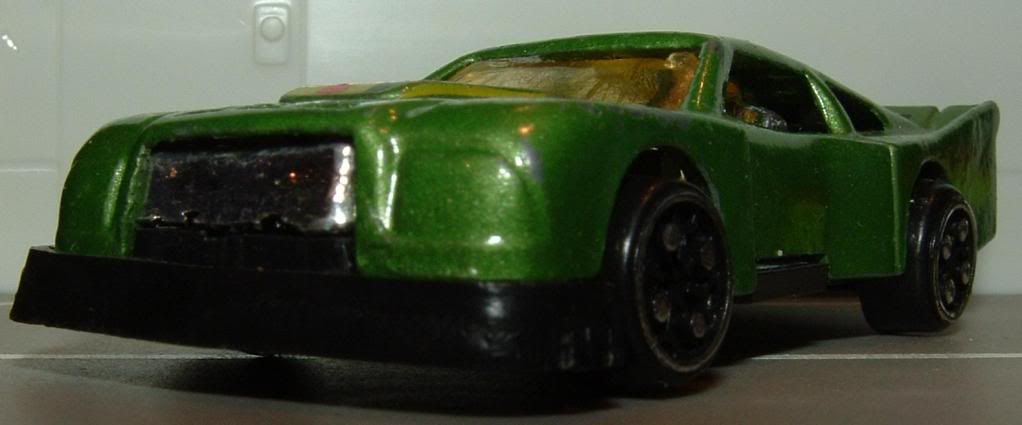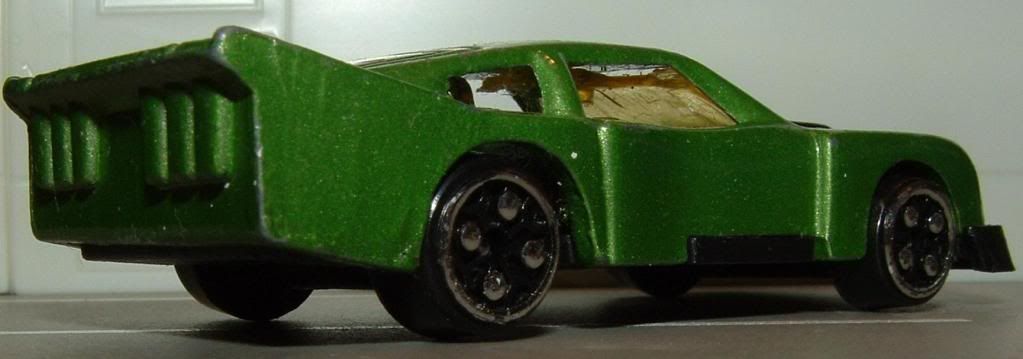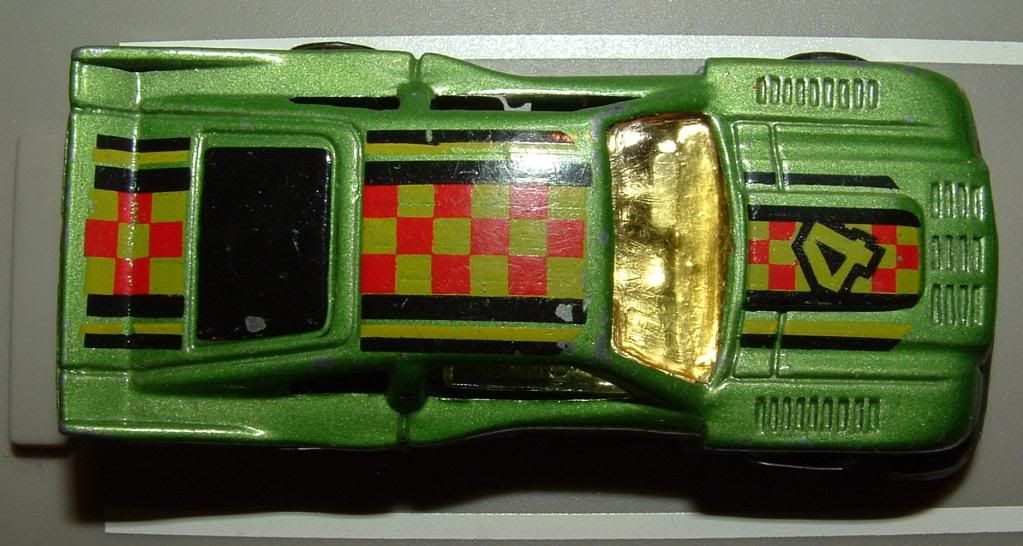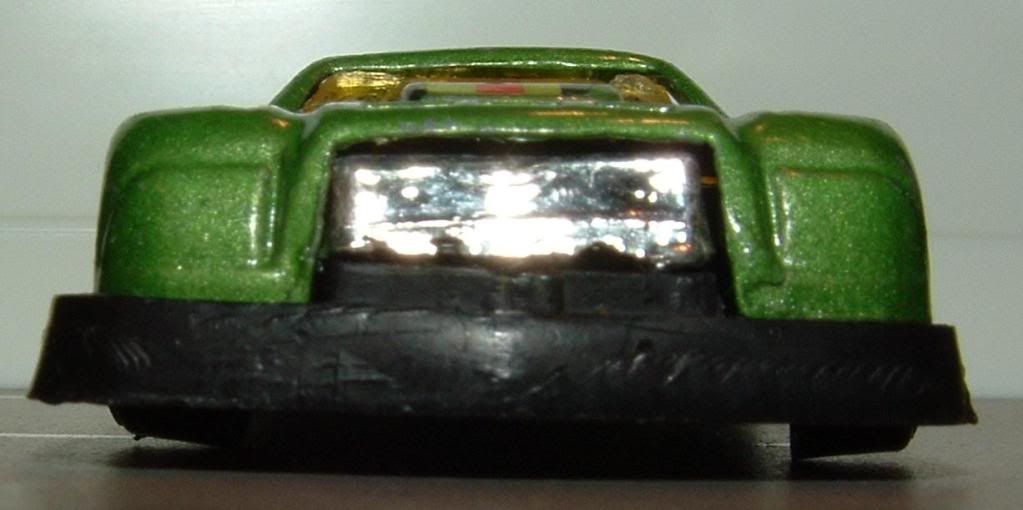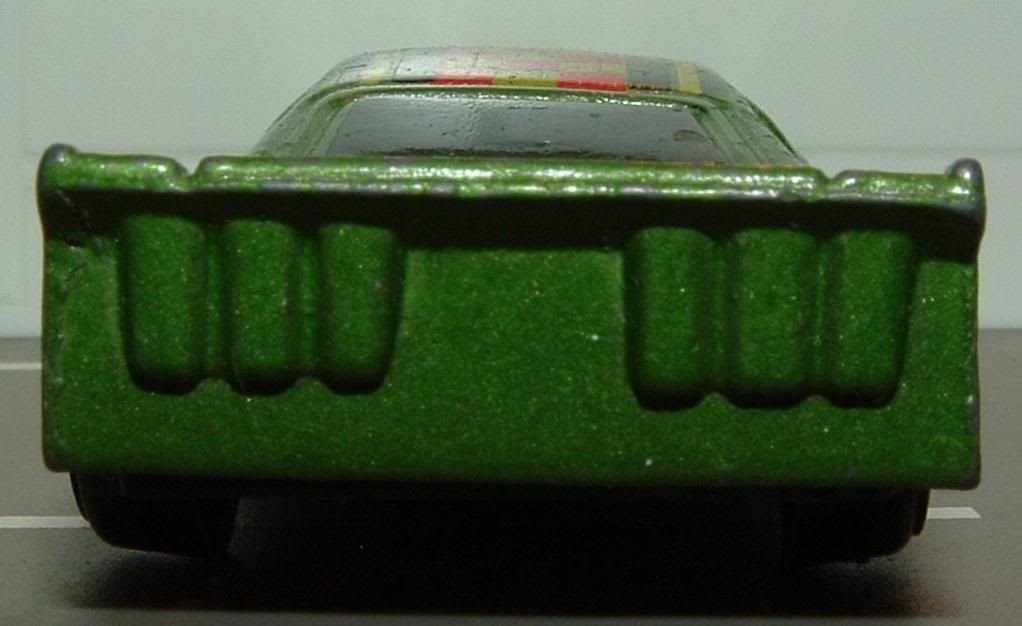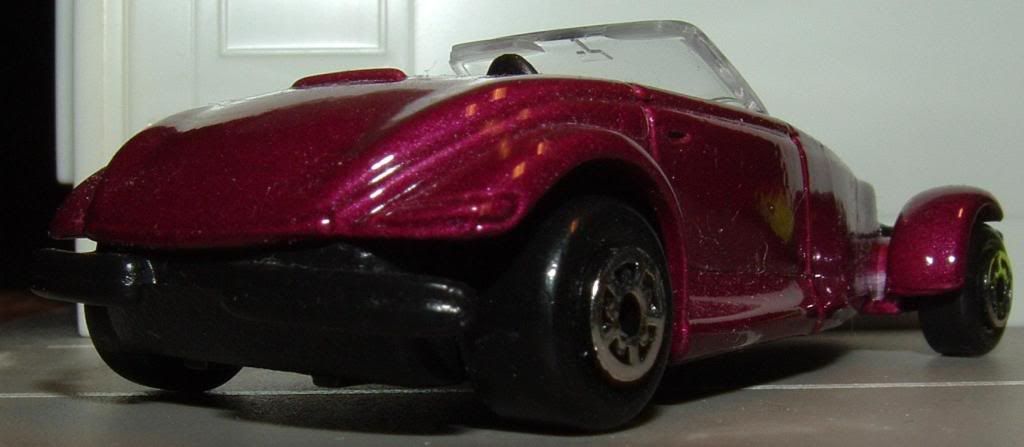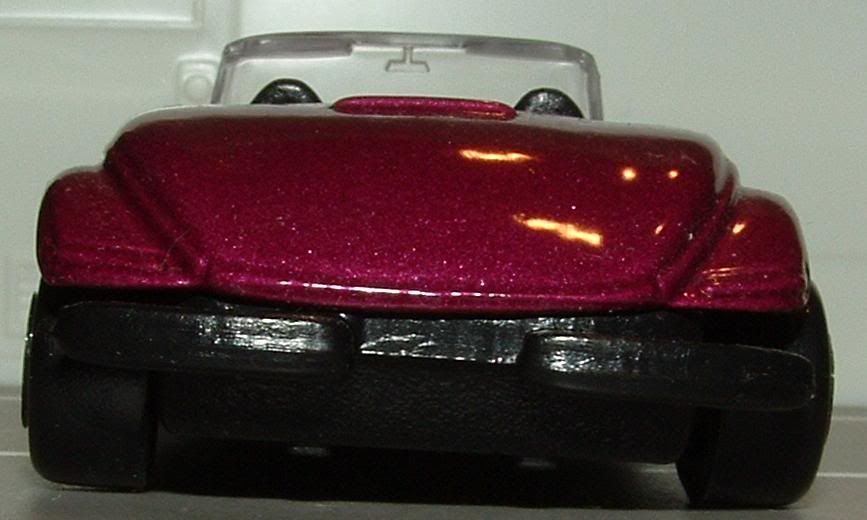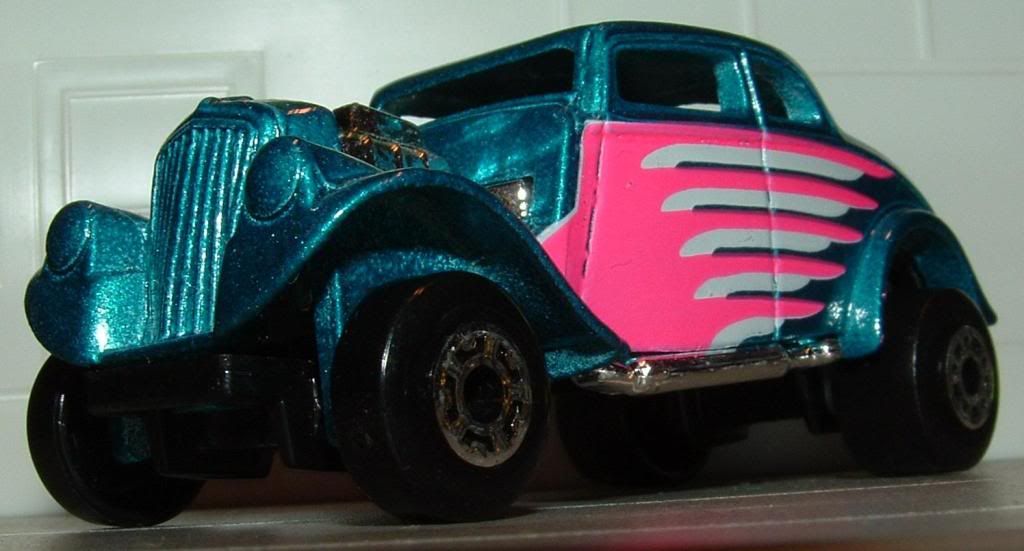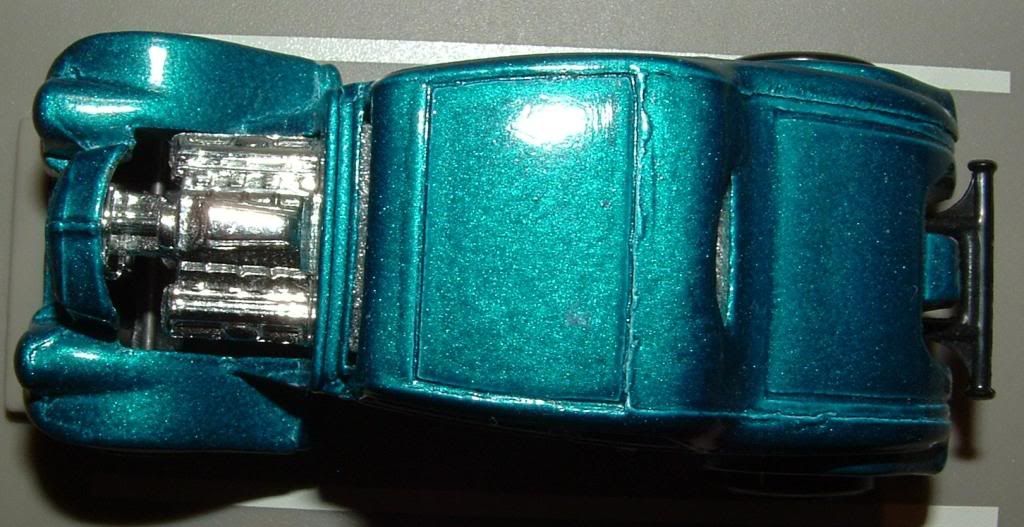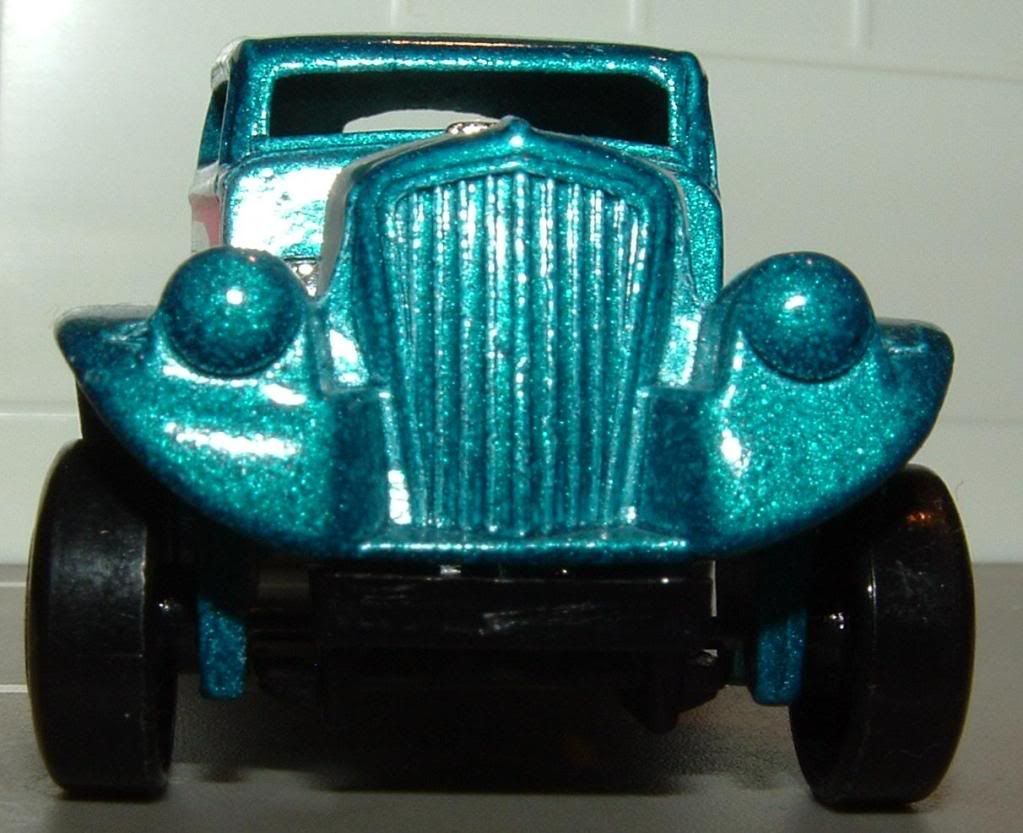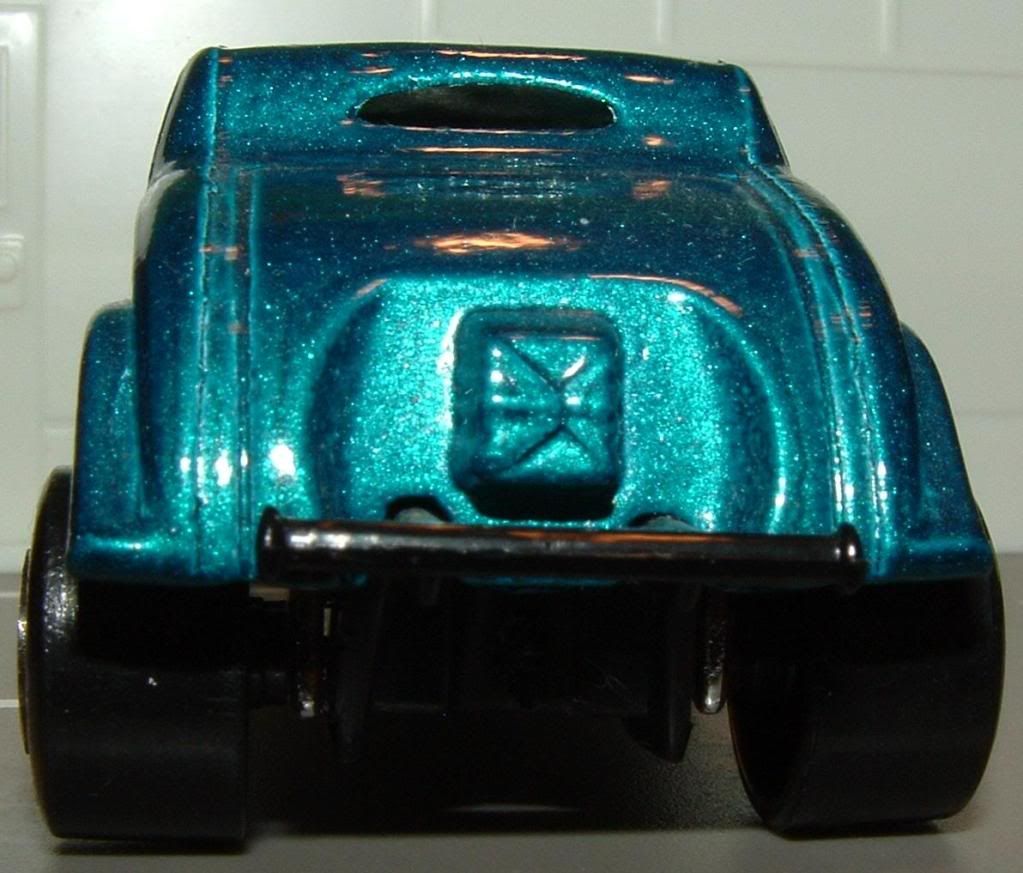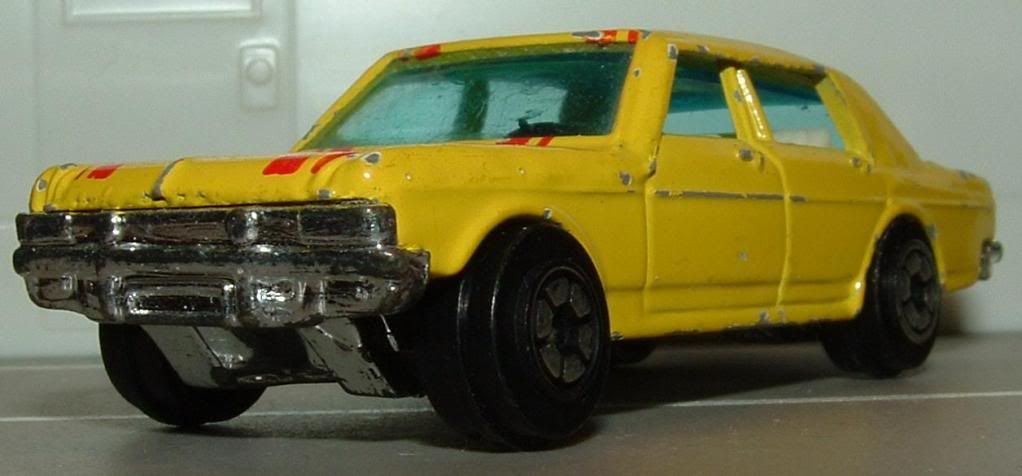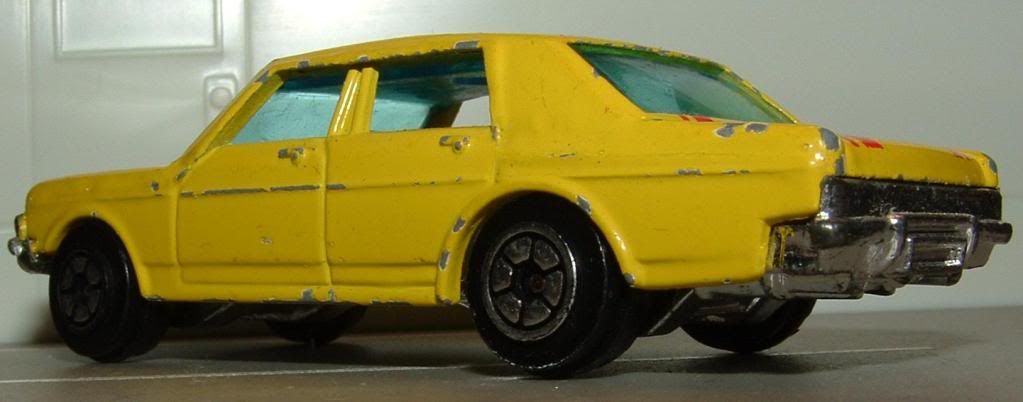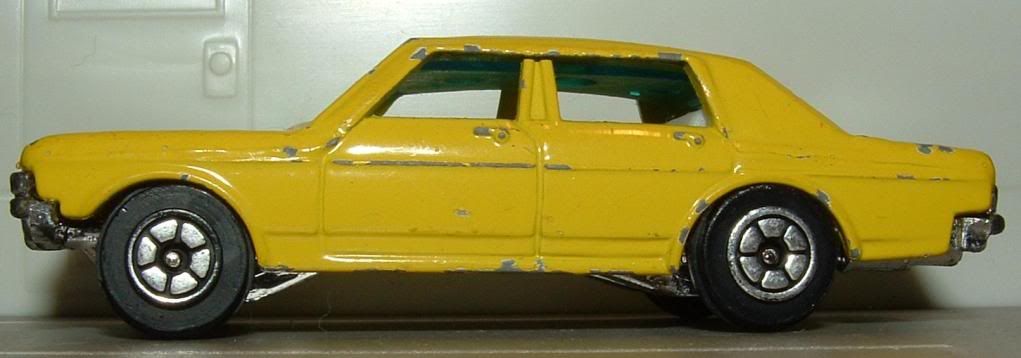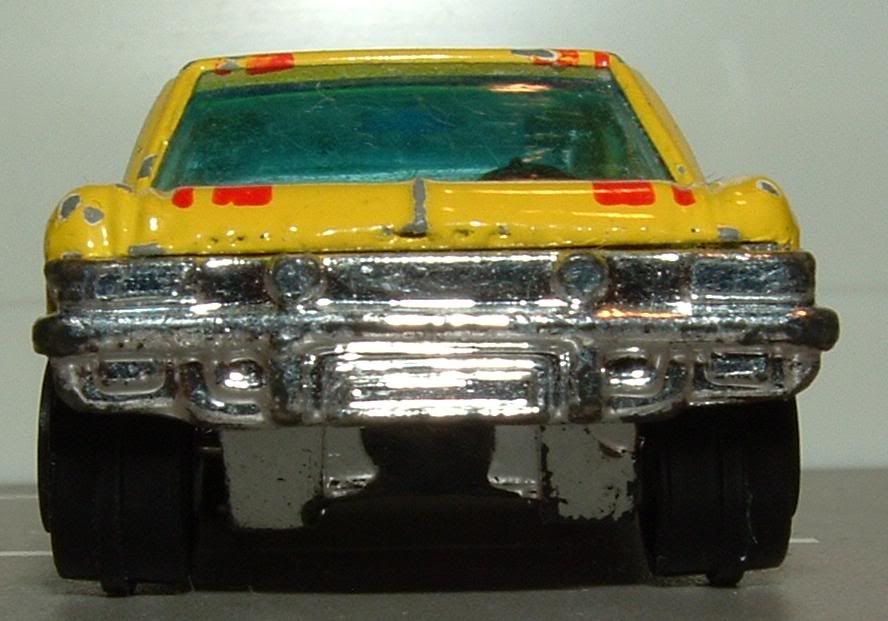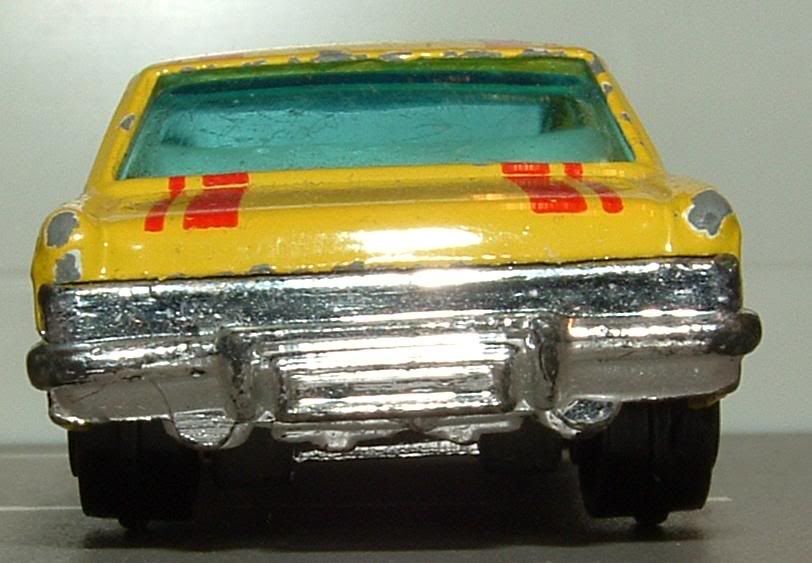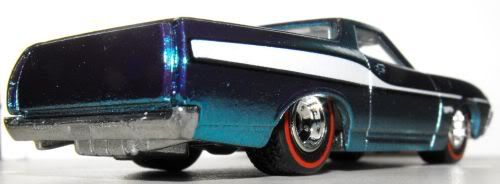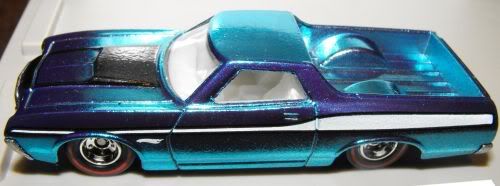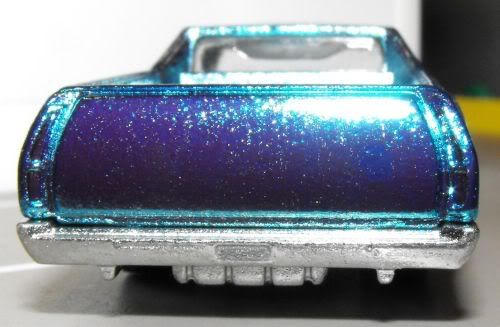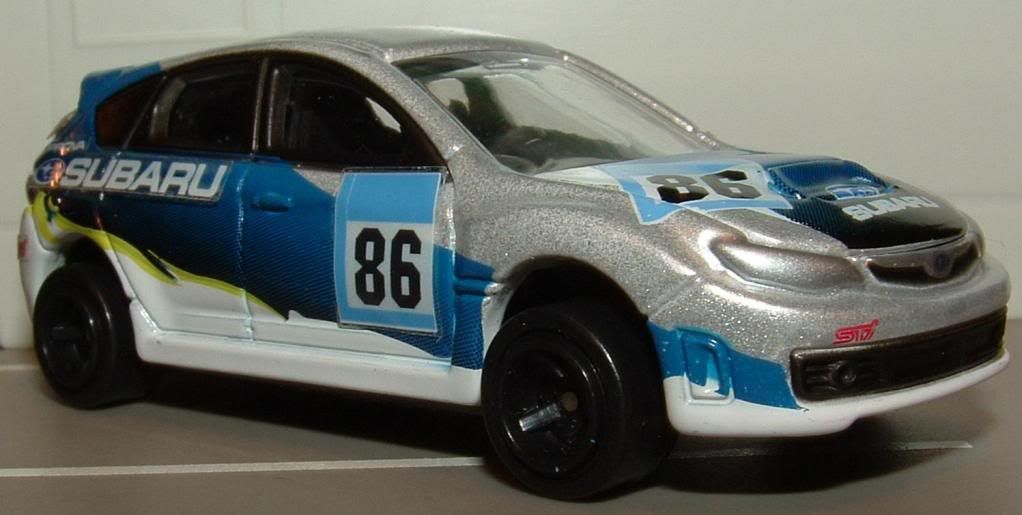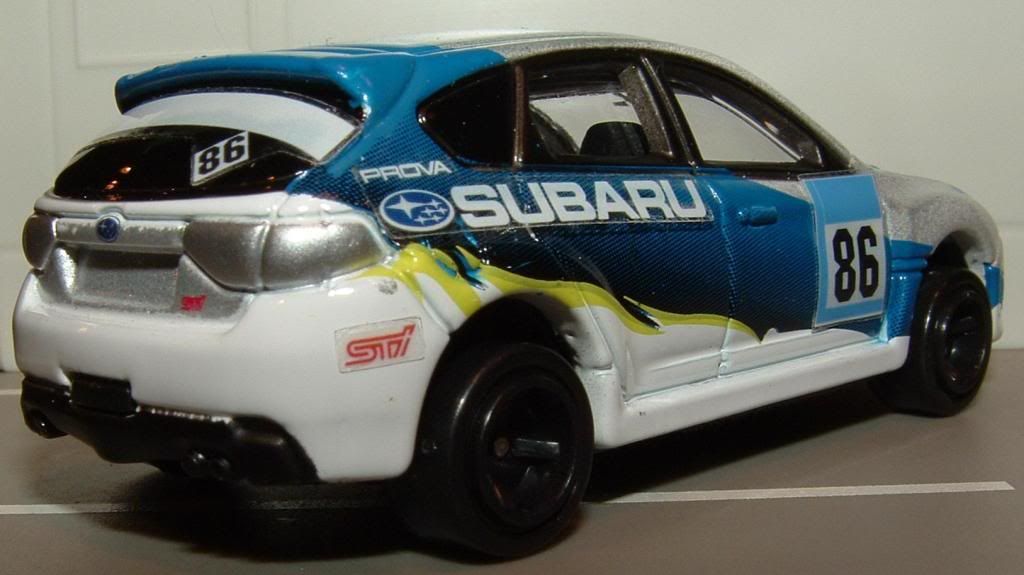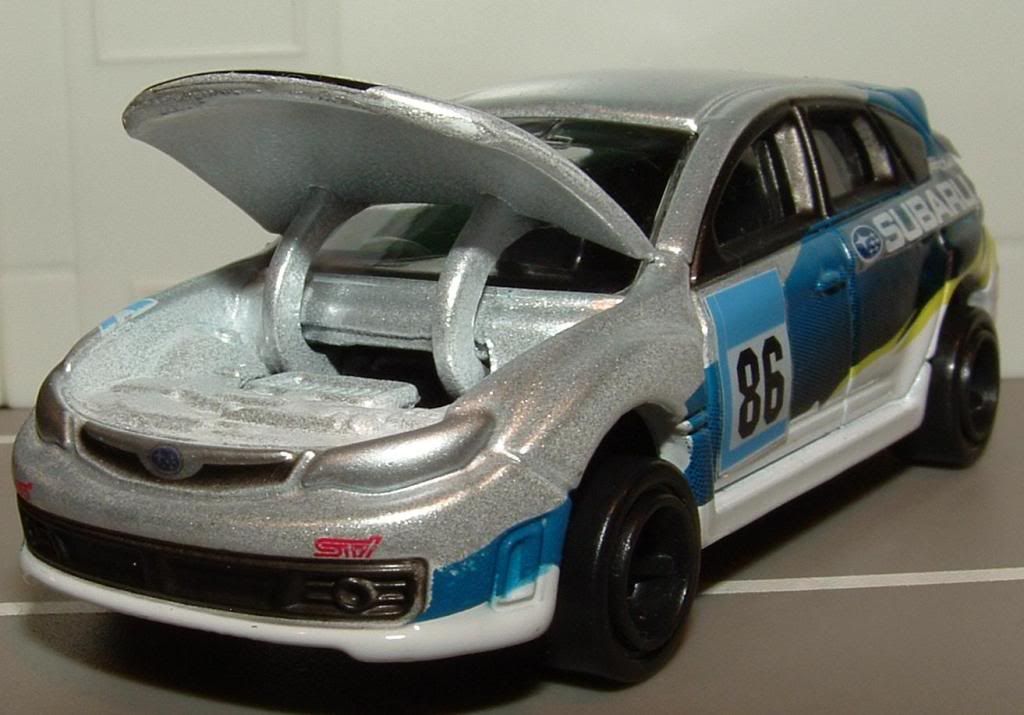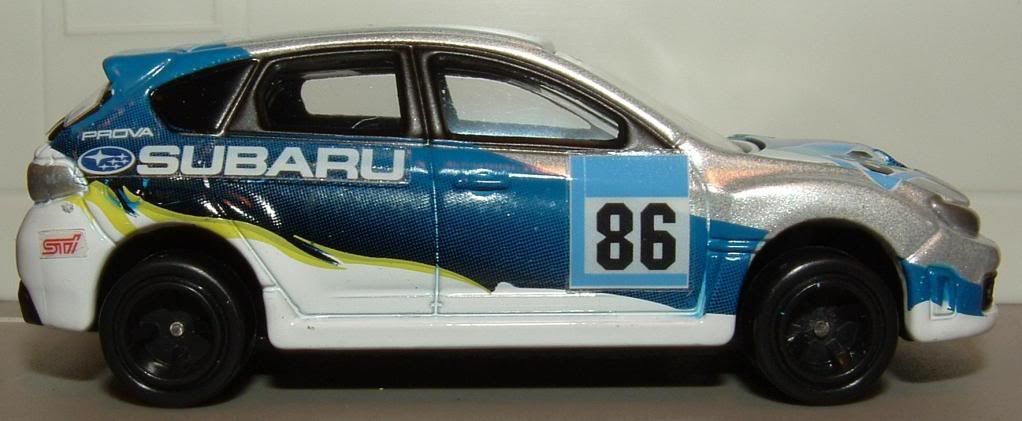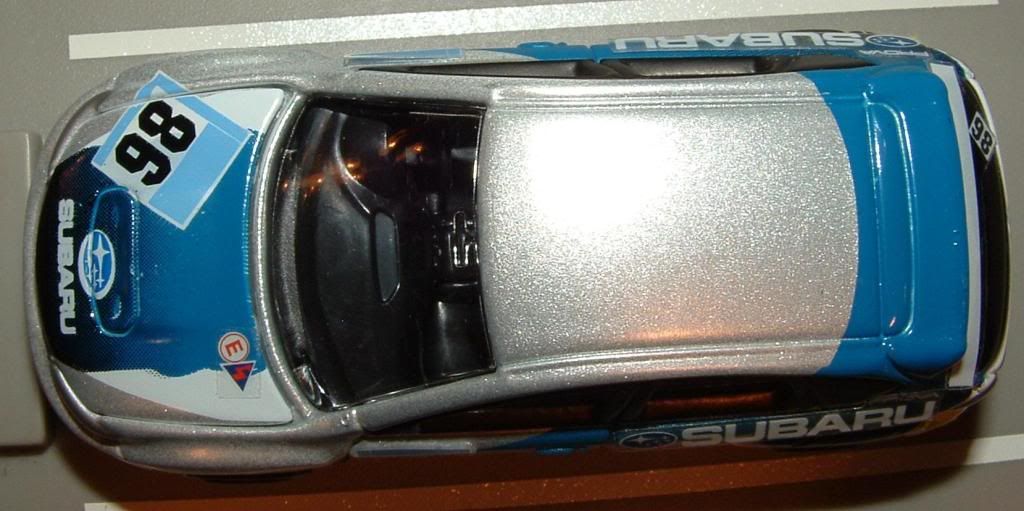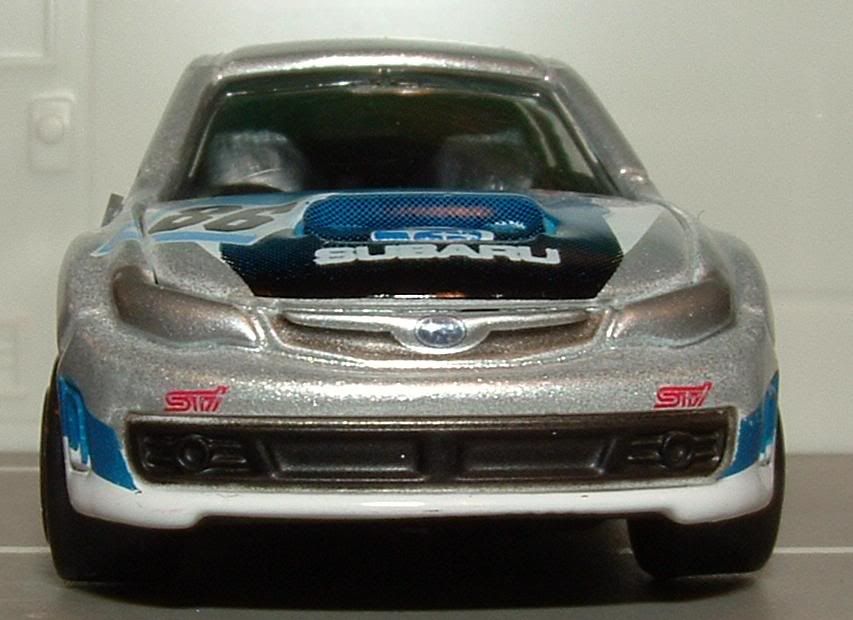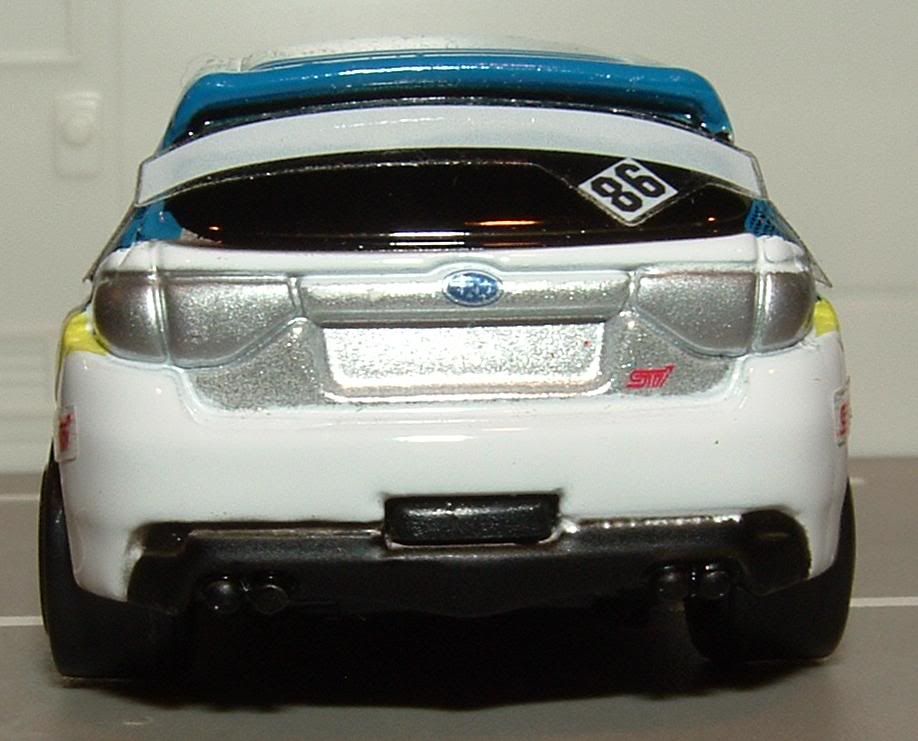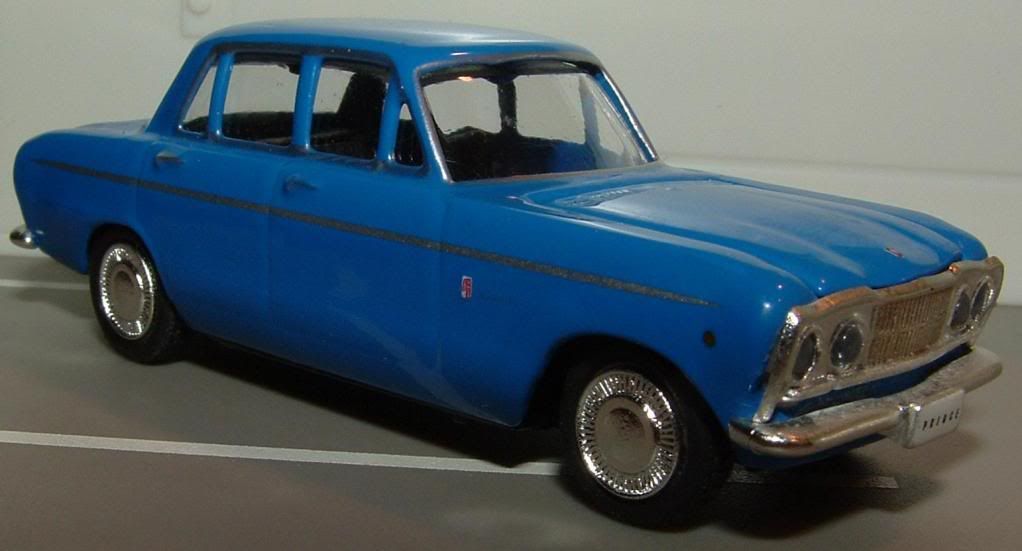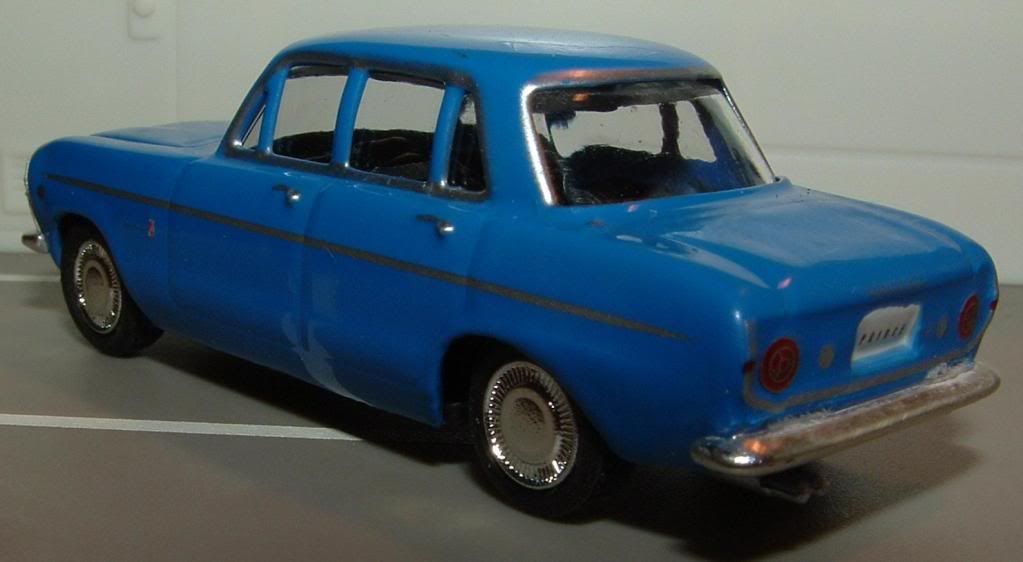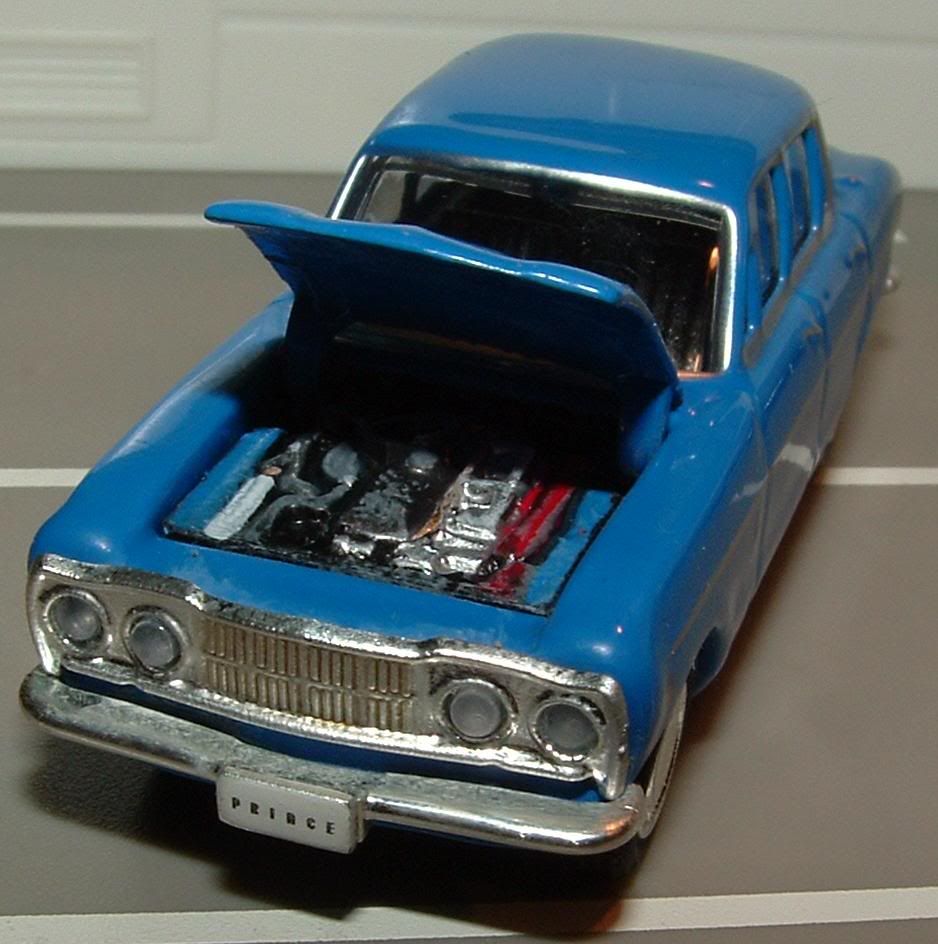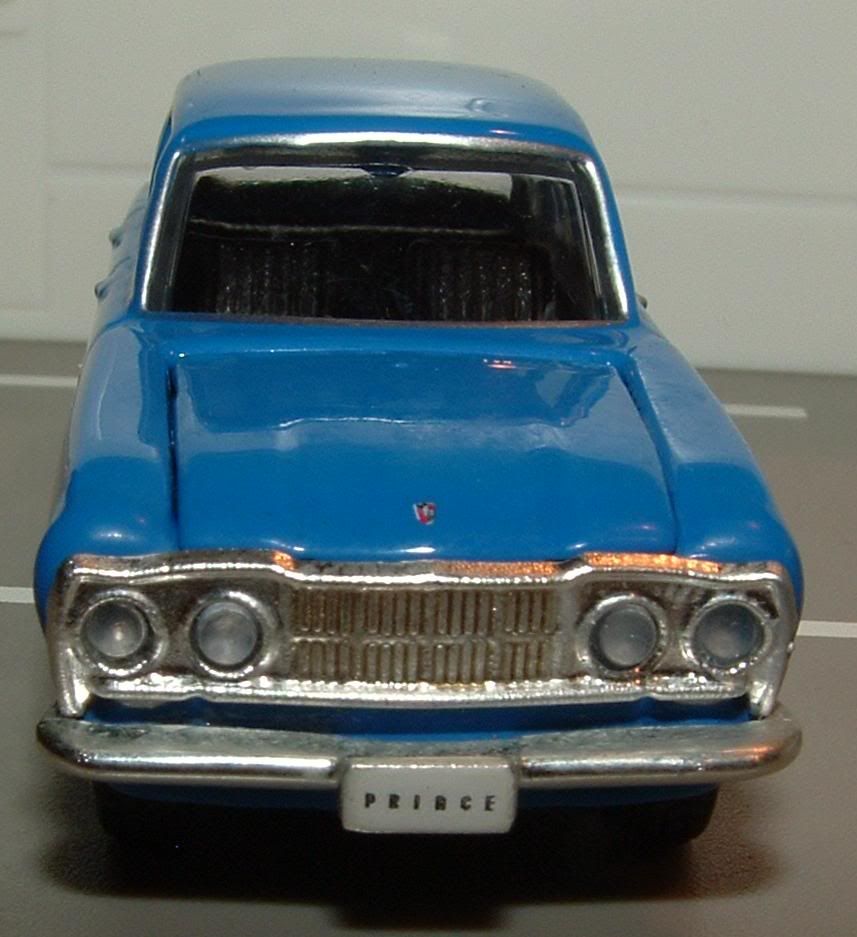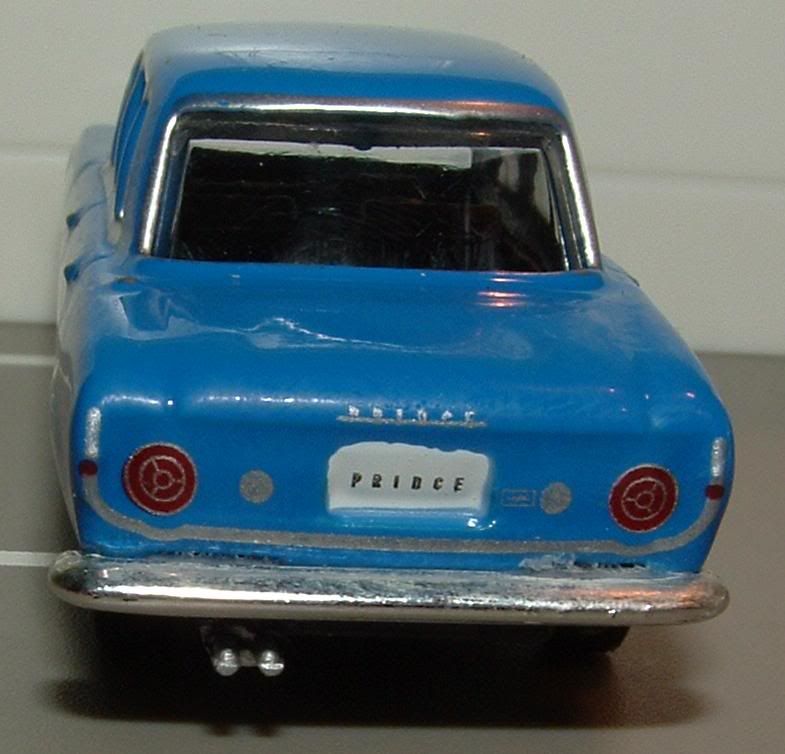
A blog focusing on 1/64 diecast from such popular brands as Hot Wheels, Matchbox, Johnny Lightning, M2 Machines, GreenLight, Tomica, Yat Ming, Majorette, MotorMax, Siku, Corgi, Guisval, Playart, Ertl, Zylmex, Racing Champions, & many more. Swifty's Garage features a daily Car Of The Day and news updates from your favorite brands!
Friday, December 31, 2010
Car Of The Day: December 31, 2010
Today's car of the day is Summer's 1977 Ford Mustang II Cobra II IMSA racer.
The first generation Mustangs grew in size; the 1973 model had become markedly larger than the original model. The pony car market segment saw decreasing sales in the early-1970s "with many buyers turning to lower-priced, fuel-efficient compacts like Ford's own Maverick - a huge first-year success itself." The Mustang was growing to become an intermediate-sized sedan, "too big and alienated many in its customer base." The allure of the original Mustang was its trim size and concept. The automakers in Detroit had "begun to receive vibrations from the only source it really listens to-new-car buyers... The message: Build smaller cars" as customers stopped buying and the inventory of unsold new cars climbed during the summer of 1973, and there were already positive market expectations for the new downsized Mustang. Automakers were "scrambling" by December 1973 as "the trend toward smaller, less extravagant cars to surge ahead faster than anyone had expected."
Subsequent to becoming president of Ford Motor Company on December 10, 1970, Lee Iacocca ordered the development of a smaller Mustang for 1974 introduction. Initial plans called for a downsized Mustang based on the compact Ford Maverick, similar in size and power to the Falcon, the basis for original Mustang. Those plans were later scrapped in favor of a smaller Mustang based on the subcompact Ford Pinto. The final product was "less of a Pinto than the '64½ had been a Falcon."
The new model would better compete with 2+2 import coupes such as the Toyota Celica, Datsun 240Z, and the Ford Capri — which itself was inspired by the original Mustang but built by Ford of Europe, and marketed since April 1970 in the U.S. by Mercury as a captive import. The design featured rack and pinion steering and a separate engine sub-frame that decreased noise, vibration, and harshness.
According to Ford's Chief Engineer, Stuart M. Frey (younger brother of Donald N. Frey) Iacocca expected a high level of fit and finish, wanting the car to be "a little jewel". The Mustang II production was 385,993 units the first year. The big 1973 Mustang total reached 134,867, but the 1974 version was within "10 percent of the original Mustang's 12-month production record of 418,812." Over five years the Mustang II recorded four of the ten top model year Mustang sales. A 2009 report confirmed Iacocca's vision for the 1974–1978 Mustang, saying it "was the right car at the right time, selling more than 1 million units in four years."
The marketplace adjusted to the oil embargo, increasing insurance rates, United States emissions and safety standards, and downturns in the economy, and waning consumer demand in the pony car segment. GM had considered discontinuing the Camaro and Firebird after 1972, and in 1974 Chrysler discontinued the Barracuda and Dodge Challenger, American Motors discontinued the Javelin, and lighter, more economical imported cars became increasingly popular — "in effect, filling the segment the Mustang had created, then abandoned."
For more information and pictures of the real car please visit: Ford Mustang II
2010 was a lousy year (at least for me) so I present some lousy pictures of a lousy casting as my send-off to this horrible year now that's it's finally over. May 2011 be a better year for everyone! This one is another childhood survivor, and it was one of two versions of this casting I had as a kid. As Summers go, it's not terrible. The most glaring default is the taillights that look much more like an original Mustang's than the Mustang II's.
The Mustang II was named Motor Trend's Car of the Year, in 1974, the only Mustang to achieve that honor until 1994. Nevertheless, there were also mixed contemporary reviews including Consumer Reports reporting that "there are better subcompacts on the market than the Mustang II" and recommended the AMC Gremlin as a car that was at least as good, and in some respects superior, in terms of seating, noise level, normal and emergency handling, and acceleration; and Road & Track was of the opinion that the Ford was neither fast nor particularly good handling.
Consumer reaction to the Mustang II was enthusiastic with a combined total production of the 1974–1978 models exceeding 1.1 million. "As the smallest, lightest Mustang since the original, it was a fresh start for Ford's pony car and a refreshing return to rationality. And it couldn't have been better timed, introduced just two months before the first "Energy Crisis" upended America. People came in droves to see the Mustang II—and to buy." "Not only did gasoline prices spike up, but its very supply looked to be in jeopardy. Economy immediately became a hot item, and this helped boost the smaller Mustang’s first calendar year sales to 385,993."
According to automotive historian, Patrick Foster, "Ford executives decided to call the car 'Mustang II', since it was a new type of pony car designed for an era of high gas prices and fuel shortages" "Many people have never warmed up to the Mustang II, some even complaining it reminds them of the Pinto. But in its day, the public and the press sang praises for the little Mustang II. After all, a car with excellent fuel efficiency, sporty looks and a low price tag will always find acceptance. Mustang II was a success, simply because it was the right car at the right time."
Writers of the past few years tend to ignore the huge successes of the Mustang II and point out flaws by today's standards. Opinions include noting in 2003 that "if there were any steps forward in technology with the Pinto chassis, it was that it had a rack-and-pinion steering gear rather than the Falcon's recirculating ball, and front disc brakes were standard," Edmunds Inside Line wrote of the Mustang II: "It was too small, underpowered, handled poorly, terribly put together, ill-proportioned, chintzy in its details and altogether subpar.
According to Edmund's, the 1974 base engine’s 88 horsepower (66 kW) was "truly pathetic" and the optional V6’s 105 horsepower (78 kW) was "underwhelming." (With the addition of mandatory catalytic converters in 1975 these outputs fell to 83 and 97 hp (72 kW) respectively.) In 1976 the "standard four [-cylinder] swelled to a heady 92 horsepower (69 kW), the V6 increased to 102 hp (76 kW), and sales were a surprisingly stable 187,567 units—a mere 1,019 less than in '75." In 1977 the engines’ power outputs dropped again, to 89 and 93 horsepower (69 kW) respectively, and production dropped "about 18 percent to 153,117 cars."
Writers of today ignore the rave reviews of 1974–1976 models, and one even describes the Mustang II as "lamentable." The New York Times said in 2006 that defective steering, together with a fuel tank of the same design as in the Pinto, a car "forever infamous for exploding when struck in the rear," caused owners an anxiety that was "heightened by the fact that some Mustang IIs had Firestone 500 tires, notorious in the 70's for widespread failures." It continued: "Ford, not content to drag the revered Mustang name through the mud...added badges from Ghia, the venerable Italian studio that it had bought, to versions of the Mustang II with partial vinyl roofs and tacky opera windows." According to Edmunds Inside Line the 1978 King Cobra "wasn't much more than a Cobra II with revised graphics and the hood scoop turned around backward..." This model was "visually about as nutty a Mustang as has ever been built" but "mysteriously, production climbed to 192,410 units."
A 1995 book on the history of the Mustang refers to the introduction of "a lukewarm optional 302 V8 in 1975" and says that "the token revival of the Cobra name—appearing as the taped-and-striped Cobra II—the following year did little to stem the tide as customers grew less enchanted with the Mustang II’s cramped quarters and weak performance." There was "a steady slide in 1976 and '77." Despite the 25-percent rise in sales for 1978, "not even the high-profile Cobra with its flashy decals and snazzy spats and spoilers could save the day for the second-generation Mustang."
A review by Edmunds concluded: "As much as the Mustang II is despised today, Ford appreciated its success back then." "The Mustang II kept the pony car spirit alive in the face of those very rough times ... no small achievement and reason enough to respect Iacocca's little jewel."
"Many Mustang enthusiasts disdained the Mustang II as an aberration, not a “real” Mustang. It was, however, a product of its time, and many find it a desirable collectible today."
Thursday, December 30, 2010
Car Of The Day: December 30, 2010
Today's car of the day is Maisto's 1997 Plymouth Prowler.
The Plymouth Prowler is a "retro" styled production car built in 1997 and 1999-2002. The Prowler was based on the 1993 concept car of the same name.
For more information and pictures of the real car please visit: Plymouth Prowler
The Prowler was filled with potential, but lacked in the execution. Most hot rodders are all about the V8, at least in the United States (the main market for this car). So a car with the looks of a vintage Deuce roadster powered by anything other than a small block V8 was missing the mark. My main point on this one is that all of Chrysler's retro cars from the '90s were based on Fords. The Ford powered Shelby Cobra inspired the Viper and the '32 Ford (customized into a Deuce roadster as was popular in the '50s) inspired the Prowler.
The design of the Prowler was said to have been inspired after Chrysler engineers were given free rein to create whatever they wanted in a "hot rod" or "sportster" type vehicle. One of the most striking design features of the Prowler are the open, Indy racer style front wheels.
Although he is officially uncredited, car designer Chip Foose's Chrysler sponsored senior project car at Pasadena's Art Center College of Design, which he dubbed the Hemisfear, evolved into the Plymouth Prowler.
The Prowler featured a powertrain lifted from Chrysler's LH-cars, a 3.5 L SOHC Chrysler SOHC V6 engine 24v producing 214 hp (160 kW; 217 PS) at 5850 rpm. For the 1999 model year the engine was replaced with a more powerful 253 hp (189 kW; 257 PS) at 6400 rpm version of the engine. Both engines were coupled to a 4-speed Autostick automatic transmission. The transmission was located at the rear of the vehicle and joined to the engine by a flexible driveshaft that rotated at engine speed, an arrangement similar to that used by the C5 Corvette, Porsche 944 and Alfa Romeo 75, and helped to facilitate a desirable 50-50 front-rear weight distribution. The Prowler was the first rear-wheel drive Plymouth since the 1989 Plymouth Gran Fury. While criticized for featuring a V6 only, Chrysler's High Output 3.5 had a horsepower rating similar to (or higher than) the company's magnum V8s of that era. While not making nearly as much torque as a V8, Prowler's light weight translated into very impressive performance figures, including off-the-line acceleration.
The car prominently featured aluminum in its construction, chiefly in the chassis. In many cases, the components were adhesively bonded. The body was produced in Shadyside, Ohio, and the car was assembled by hand at the Conner Avenue Assembly Plant (CAAP) in Detroit, Michigan.
Wednesday, December 29, 2010
Car Of The Day: December 29, 2010
Today's car of the day is Matchbox's 1933 Willys 77 hot rod.
Willys (pronounced "Will-is") was the brand name used by the United States automobile company Willys-Overland Motors, best known for its design and production of military Jeeps (MBs) and civilian versions (CJs) during the twentieth century.
For more information and pictures of the real car please visit: Willys 77
Models of stock 1930s cars are uncommon in 1/64 scale. Oddly enough, Hot Wheels has been among the most prolific producer of stock cars from this time period. However, hot rods from the 1930s become more commonplace every year. This was Matchbox's foray into vintage hot rods.
In 1926, production of the Overland ended and was replaced by the Whippet brand of small cars. Following the stock-market crash of 1929 and the economic depression that soon followed, a number of Willys automotive brands began to falter. Stearns-Knight was liquidated in 1929. Whippet production ended in 1931, its models replaced by the Willys Six and Eight. Production of the Willys-Knight ended in 1933.
At this point Willys decided to clear the boards and produce two new models - the 4-cylinder Willys 77 and the 6-cylinder Willys 99 - but the firm was on the verge of bankruptcy again, so only the 77 went into production. They were forced to sell their Canadian subsidiary, itself in weak financial shape, and started a massive reorganization. In it, only the main assembly plant and some smaller factories remained property of Willys-Overland. The rest were sold off to a new holding company that leased some of the properties back to W-O. The company was thus able to ride out the storm.
In 1936 the Willys-Overland Motor Company was reorganized as Willys-Overland Motors. In the 1920s and 1930s, Willys was an unremarkable automaker based in Toledo, Ohio, one of dozens in the U.S. It was one of several bidders when the War Department sought an automaker who could begin rapid production of a lightweight truck based on a prototype designed by American Bantam.
Tuesday, December 28, 2010
Car Of The Day: December 28, 2010
Today's car of the day is Yat Ming's 1970 Opel Admiral.
The Opel Admiral was a luxury car made by the German car manufacturer Opel from 1937 to 1939 and again from 1964 to 1977.
For more information and pictures of the real car please visit: Opel Admiral
One of Yat Ming's original 24 models, this one is purely Yat Ming- it's obviously a copy of something (all early Yat Mings are) but this one appears to have been shrunken from a larger scale offering. Does anyone know what may have inspired this one? As far as I know this is the only Admiral in small scale.
The Admiral B was introduced just in time for the Geneva Motor Show in March 1969 together with the new Kapitän and Diplomat. While the Kapitän was discontinued after May 1970, Admiral and Diplomat survived until 1977; they were replaced by the Senator in 1978.
Over the whole production run, the Admiral B was available exclusively with a 2.8 liter-inline six in either 1-bbl (132 PS/130 hp; Opel Admiral) or 2-bbl (145 PS/143 hp; Opel Admiral 2800 S) form or with fuel injection (165 PS/163 hp; Opel Admiral E). This was the first time fuel injection had been offered as an option in an Opel. All engines could be paired with a 4-speed manual or with Opel's own 3-speed automatic transmission. From January 1972 the manual was no longer available with the Admiral E, leaving the automatic as the only choice. For the back axle, the big change for the Admiral B was the fitting of a De Dion tube based suspension.
For the model year 1975, the six was reworked and downrated to 129/140/160 PS in a move to reduce emissions.
Opel built about 33,000 Admiral B models from 1969 to 1977.
Monday, December 27, 2010
Car Of The Day: December 27, 2010
Today's car of the day is Hot Wheels' 1972 Ford Ranchero.
The Ford Ranchero was a coupe utility produced between 1957 and 1979. Unlike a pickup truck, the Ranchero was adapted from a station wagon platform that integrated the cab and cargo bed into the body. A total of 508,355 units were produced during the model's production run. It was adapted from full-size, compact and intermediate automobiles by the Ford Motor Company for the North American market. Variations based on the original 1960 US Falcon for home markets in Argentina and South Africa were produced through the late 1980s. It sold well enough to spawn a competitor from General Motors in 1959, the Chevrolet El Camino.
For more information and pictures of the real car please visit: Ford Ranchero
General Motors keeps rumoring that the Holden Ute will make it to the United States- originally Pontiac was to get it as a version of the G8, but when GM went into bankruptcy that (and Pontiac itself) went out the window. Now the rumors are coming out that GM is looking at bringing the Ute to the USA as a Chevrolet El Camino (which should have been the plan all along). Ford has a perfectly good ute based on the Australian Falcon, that would make a dandy Ranchero for the rest of the world. While GM keeps flip-flopping, the new "One Ford" strategy should be looking at bringing this vehicle to new markets.
1972 saw a radical change in the Torino and Ranchero lines. The sleek, pointy look of the previous year's model was replaced with a larger, heavier design. Most prominent was a wide, gaping 'fishmouth' grille and a new body-on-frame design. There were still three models available; the now-standard 500, the new Squire with simulated woodgrain "paneling" along the flanks and the sporty GT. Engine choices remained basically the same beginning with the 250 cubic inch six-cylinder and a selection of V8s that ranged from the standard 302 to Cleveland and Windsor series 351s, plus the new-for-1972 400. The 385-series V8 (the 429 for 1972-73; the 460 for 1974-76) was still available. However, all suffered from lower compression ratios to better meet new emissions standards. The 351 cu in (5.8 L) Cleveland could still be obtained in tuned 4-V Cobra Jet form through 1974. A four-speed manual transmission was available on Cobra Jet-powered GT models.
The 1973 Ranchero saw a redesigned front-end to meet new federal standards for front impact protection. Aside from slight cosmetic differences, the Ranchero would remain basically the same until the Torino's final year, 1976.
Sunday, December 26, 2010
Car Of The Day: December 26, 2010
Today's car of the day is Tomica's 2008 Subaru Impreza WRX STi.
The Subaru Impreza WRX is a turbocharged version of the Subaru Impreza, an all-wheel drive, four-door passenger vehicle. It is available as a sedan or wagon.
Originally introduced in 1992 in Japan, then shortly afterward in New Zealand, Australia and Europe, the WRX had a turbocharged flat-4 2.0L (then later a 2.5L), Subaru Boxer engine. Compared to the base Impreza, the WRX has a turbo-charged drivetrain, wider low-profile tires, larger brakes, and firmer, higher-quality suspension components.
The Impreza WRX was first sold in North America in 2001 as a 2002 model year.
For more information and pictures of the real car please visit: Subaru Impreza WRX STI
Some Tomicas come with stickers to apply. This is one of them, so if they seem a little off, I did my best!
The Impreza WRX was redesigned for the 2008 model year and is now based on a shortened Subaru Legacy platform. The new chassis represents a departure from some Subaru traditions with full framed doors and a hatchback body style for the STI and WRX versions. Subaru made an effort to control the weight of the new chassis. Despite the increase in size, stiffness, and safety equipment, the car's weight is similar to the previous chassis at 3,142 lb (1,425 kg) for the 5 speed manual and 3,208 lb (1,455 kg) for the 4 speed automatic.
The engine used is still the EJ255. The front suspension uses a MacPherson strut setup with steering ratio of 15:1, while the rear is a new double wishbone suspension. The US-spec WRX reverts back to a 2-piston/1-piston sliding calipers (dropping the 4-piston/2-piston fixed caliper setup), but have grown to 11.6-inch (295 mm) in the front and 11.3-inch (287 mm) in the rear, the same as the BL5-chassis US-spec Legacy 2.5GT and Spec B.
The 2008 STI has received a higher degree of parts to differentiate it from its Impreza WRX brethren. Unlike the Impreza WRX, the STI uses aluminum suspension components, is only available as a 5-door hatchback, and has different fenders that are 2.2 in (56 mm) wider. It adopted "Subaru Intelligent Chassis Design" and "Dynamic Chassis Control Concept". The turbo forces air through a larger top-mount-intercooler which has lost the red "STI" that was on previous generations. It is the first generation of this model with an automatic transmission which is able to import to outside Japan.
Like other 2008 Impreza models, the 2008 STI benefits from a lower polar moment of inertia due to smaller overhangs, and also features a double wishbone rear suspension. The car also borrows new intake and exhaust components from the Legacy GT platform.
The latest Impreza WRX STI features Multi-mode Vehicle Dynamics Control (VDC) with "Normal", "Traction", and "Off" modes, Subaru Intelligent-Drive (SI-Drive) with 3 modes: Intelligent, Sport, and Sport Sharp (S#), and Multi-mode Driver's Controlled Centre Differential (DCCD). The DCCD enables driver to select the manual or auto: "auto", "auto+", and "auto-" mode in order to distribute the torque based on driving preference or conditions.
The JDM version has a 2.0L 308 PS (227 kW; 304 bhp) EJ207 engine with a Twin scroll turbocharger, while other versions of the car have a 2.5L 300 PS (221 kW; 296 bhp) EJ257 engine with a single-scroll VF48 turbocharger.
At the New York Auto Show, a Subaru spokesman confirmed that the Impreza WRC will be based on the hatch platform, due to its lower polar moment of inertia.
The latest US model of the STI has 305 bhp (227 kW; 309 PS) and 290 ft·lbf (390 N·m). of torque and range in price from $35,640 to $39,440, depending on the options included. The 2008 Impreza STI has the model code GR, reflecting the different "wide body" 5-door Hatchback compared to the GH standard body 5-door Hatchback used for the 2008 Impreza WRX and non-turbo models. The new "wide body 5-door" chassis is 70.7 in (1796 mm) wide compared to 68.5 in (1740 mm) for the regular WRX 5-door chassis. Kerb weight varies from 1,505 kg (3,318 lb) to 1,540 kg (3,395 lb) depending on the options.
In 2008, a Subaru WRX STI spec C was in the works for production. It had been spotted lapping the Nurburgring. It is expected to shed 70 kg (154 lb) in weight, have minor engine tweaks, have an updated aero kit, and bigger brakes.
A possible precursor to the WRX STI spec C had surfaced at the MotorSport Japan 2008 auto show, named the Subaru Takumi concept. The only visual cues to differentiate this car from the regular STI are a blacked-out rear spoiler, front lip spoiler, and 12-spoke wheels that are strikingly similar to the ones featured on the spec C test mule spotted around the Nurburgring. The upgraded parts included on the car are drivetrain and suspension modifications. There is no word on performance figures or power output. It was later confirmed by Autoblog that the Takumi concept was in fact just an unveiling of the 20th Anniversary Edition WRX STI and not the spec C. All 300 examples will be exclusive to the Japanese market.
Subaru launched the Impreza WRX STI A-Line with a five speed semi-automatic gearbox on February 24, 2009. Available initially only in Japan and Singapore, the A-Line features include “Downshifting Blipping Control” and steering wheel-mounted paddles. The engine and transmission in the A-Line are very similar to 2007-2009 Legacy 2.5 GT models. However, the A-line has less torque (35.7kgfm) and slower acceleration (0 to 100 km/h takes 6.1 seconds) compared to the manual STI version. The A-Line is also offered in Hong Kong, and later in Indonesia with debut at the 2010 Indonesia International Motor Show in July 2010, and will be exported to Australia in 2011.
Finally, on July 23, 2009, the Subaru Impreza WRX STI spec C was released in Japan. The 900 units limited edition WRX STI spec C has engine, suspension, and body parts improvement over the regular model. The ball bearing on the turbine axle had been modified to reduce friction, the ECU had been retuned for better response, and an intercooler water spray was fitted to prevent rise in the air temperature. The cross member, suspension and power steering were also improved for better handling and body rigidity. Aluminium hood, laminar window glasses, and lighter battery helped to reduce weight.
Subaru (UK) Limited introduced two new WRX STI models at the British Auto Show that have specific tuning by Prodrive. The first is WRX STI 330S, intended to compete with the UK-spec Lancer Evolution X FQ-330. It produces 330 PS (243 kW; 325 bhp) and has a 0-60 mph time of 4.4 seconds. The last of the two would be the WRX STI 380S. It could make it into production within 6 months, pending positive consumer reception. It sports new wheels and an upgraded body kit. It is expected to produce 380 PS (279 kW; 375 bhp). Currently, there are no other specs for the car. Subaru announced, on September 10, 2008, that the 380S variation will not be produced, due to homologation and specification difficulties. The regular model is called WRX STI Type UK.
The Singaporean, Indonesian, and Australian (all RHD countries) markets received the 2.5 liter Euro-spec version instead of the J-spec version, producing 296 horsepower (221 kW) and 407 N·m (300 lb·ft) of torque. Some of Impreza WRX STI's sold in Indonesia are the 2.0 liter JDM spec brought by the general importers before Subaru officially introduced the 2.5 liter model. In Australia the regular WRX STI is sold alongside the WRX STI spec.R which comes with BBS wheels and Recaro seats.
For 2010 model year, Subaru of America introduced the Impreza WRX STI Special Edition. Similar to JDM WRX STI Spec C, this model came with stiffer suspension and thicker stabilizer bar for better handling. It also has 7 twin-spokes dark gray 18 inch alloy wheels. Inside, the limited-run Special Edition STI got manual air conditioner and 4-speaker stereo instead of automatic climate control and 10-speaker premium audio on the regular WRX STI.
Saturday, December 25, 2010
Car of the Day : December 25, 2010

The car for today is the 1956 Ford Fairlane by Muscle Machines.

The Ford Fairlane was an automobile model sold between 1955 and 1971 by the Ford Motor Company in North America. The name was taken from Henry Ford's estate, Fair Lane, near Dearborn, Michigan.
Over time, the name referred to a number of different cars in different classes; the Fairlane was initially a full-size car but became a mid-size car from the 1962 model year. The mid-sized model spawned the Australian-built Fairlane in 1967, although it was considered a large car there.


For 1955, the Fairlane name replaced the Crestline as Ford's premier full-size offering. Six different body styles were offered, including the Crown Victoria Skyliner with a tinted, transparent plastic roof, the regular Crown Victoria coupe with lots of stainless steel trim, a convertible Sunliner, Victoria coupe, and traditional sedans. All featured the trademark stainless-steel "Fairlane stripe" on the side. Power options were a 223 CID (3.7 L) straight-6 engine and a 272 CID (4.5 L) V8.
1956 saw few changes; a 4-door Victoria hardtop was introduced, and two new, more powerful V8 options, of 292 CID (4.8 L) and 312 CID (5.1 L), the latter available up to 225 brake horsepower (168 kW).Lifeguard safety package was introduced.


Today's COTD is via Juantoo3 and is our Christmas car for the day! Thanks Wes.


Friday, December 24, 2010
Car Of The Day: December 24, 2010
The Nissan Skyline is a line of compact cars originally produced by the Japanese carmaker Prince Motor Company starting in 1957 and subsequently by Nissan after the two companies merged in 1966. It is currently available in either coupé, or sedan body styles, and are most commonly known by their round brake lights, with the wagon form being dropped in 1989 with the introduction of the R32 platform. Currently a type ECR33 GTS25-T is the worlds fastest Skyline, capable of running through the quarter mile traps in just over 6 seconds.
Iterations R30 to R35 of the Skyline are still popular tuner cars for Japanese car enthusiasts from the 1980s to today, especially with available features such as straight-6 engines, turbochargers, and the high-performance GT-R trim. While not distributed in the United States, the Skyline's prominence in video games, movies and magazines resulted in many such cars being imported there from 1999 to late 2005, after Motorex petitioned the National Highway Traffic Safety Administration to allow 1990-1999 GT-Rs and GTSs to be imported, at the condition that they were modified to meet United States Federal Motor Vehicle Safety Standards.
The 11th generation Skyline (V35) was a major turning point for the nameplate, as it dropped the Skyline's trademark characteristics such as the straight-6 engine and turbocharging, eventually separated the GT-R into its own line, and moved to V6-engined era, this decision which extended to all later Skylines. Nissan decided to position the Skyline for the luxury-sport market, while its platform-mate, the 350Z, revived the Z line of pure sports cars. The V35 was the first Skyline made for export to North America, being sold under Nissan's luxury marque Infiniti as the G35. The Skyline (V36/J50) is sold in Europe, North America, South Korea, Taiwan, and the Middle East as the Infiniti G37.
April 11, 2010 saw a world record for the biggest ever Nissan Skyline meet and the most ever officially recognized on a track in the Guinness Book of World Records. This took place at Silverstone, United Kingdom at the ISTS event.
For more information and pictures of the real car please visit: Prince Skyline
This is the only Taccar in my collection, and I'm curious if someone can educate me on if this is a Targa Taccar or a Taccar Targa? What I do know is this is a nice model, and I love the opening hood with engine detail!
In 1961 Fuji Precision Industries changed its name to Prince after the 1954 merger, and the S50 series was launched, which like its predecessor, came in sedan and wagon bodystyles. This was the second generation car, and became one of the more desirable cars in Japan. It was powered by the G-1 engine, a 70 hp (52 kW) version of the old GA-4. A 1862 cc engine was also available, delivering 91 hp (68 kW). The S50 series were available with a 3-speed column shift transmission or a 4-speed floor shift transmission, as well as a 4-door sedan (S50) or a 5-door wagon (W50).
In 1962, this model was restyled as the S21S series.
Three models of the S50 were built: S50E (1962–1965), S50E-2 (1965–1966), and S50E-3 (1967). All three used the same engines.
The S50 was further developed with new styling for 1963, and was sold in some markets with an A150 designation. The S50 was also sold as the A190D, which was equipped with a diesel engine.
In 1966, Nissan and Prince merged and the S50 also appeared with Nissan Skyline badging. This model lasted in production through 1967. In 1967, the S50E-3 was introduced. It was sold as Prince Skyline, Prince A150, PMC A150, or Nissan A150.
Subscribe to:
Posts (Atom)
